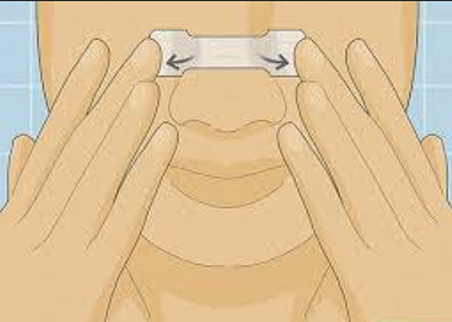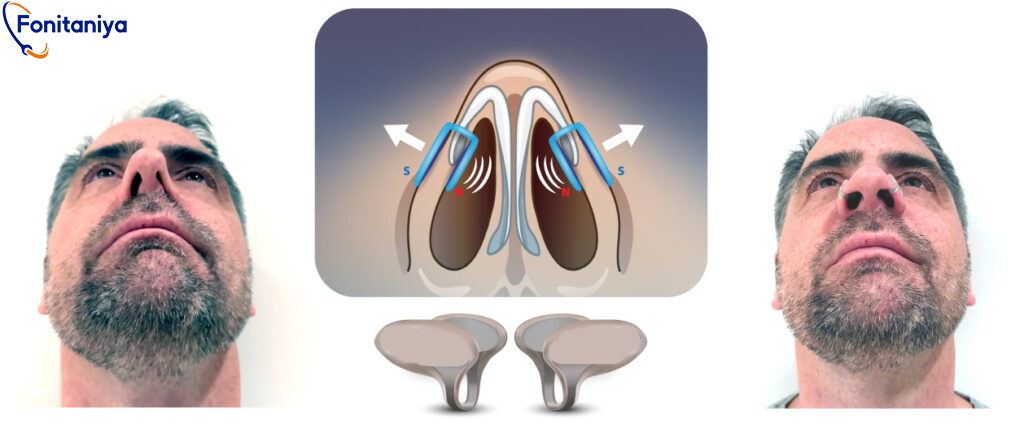Nasal dilators are fascinating tools for improving breathing. Let’s dive deep into how these small devices pack a big punch, whether they can reshape your nose over time, their safety credentials, what users really think, and finally, some expert opinions on the matter.
How Do Nasal Dilators Work?
Mechanics of Nasal Dilators
Nasal dilators work by increasing the amount of airspace in the nostril, which reduces airway resistance, making it easier to breathe. They come in two main types: external and internal. External dilators, like the well-known Breathe Right® strips, pull the nostrils and sides of the nose open from the outside. Internal dilators, such as the Nas-air® or Mute™, are inserted into the nostrils and gently push outwards, expanding the nasal passages from within.

Nasal dilators work by stretching nostrils from inside or outside
Impact on Airflow and Breathing Efficiency
Recent computational studies have shown that these devices can increase airflow by up to 24%, which is a big deal for those struggling with congestion, snoring, or even during intense workouts. This improvement in airflow can lead to better oxygen saturation during exercise and more restful sleep.
Suitability for Different Users
Not everyone will experience the same benefits from nasal dilators. For instance, people with a deviated septum may find more pronounced relief from internal dilators, while those with more general nasal congestion might prefer the simplicity of external types.
Do Nasal Dilators Change Nose Shape?
Long-term Use and Nasal Structure
One common concern is whether the repeated use of nasal dilators can lead to permanent changes in the structure of the nose. According to research from the Allergy, Asthma, and Clinical Immunology, the use of internal nasal dilators does not cause any lasting deformation as the nasal structure returns to normal once the nasal dilators are removed. The study analyzed users over a 12-month period and found no significant alteration in nasal structure.

For users who suffer from nasal deformity, nasal dilators can only relive the symptom while wearing them, without any further impact once removed
Material and Design Considerations
The design and material of nasal dilators are also important for not changing the shape of nose. Manufacturers typically make most nasal dilators from soft, flexible materials like silicone or plastic. For instance, products like the Mute Snoring Nasal Dilator are specifically designed with malleable materials that conform to the inside of the nostril without exerting excessive outward pressure.
To learn more about different types of nasal dilators, please read one of our other articles here.
Are Nasal Dilators Safe for Sensitive Users and Prolong Use?
Medical and Scientific Endorsements
Nasal dilators have been extensively studied and are generally considered safe to use. A review published in the Journal of Laryngology & Otology underscores that nasal dilators are non-invasive and do not introduce any pharmaceutical agents into the body, which substantially lowers the risk of side effects compared to medicated options.
Potential Side Effects
While nasal dilators are safe, they are not completely free of potential side effects. Some users may experience minor discomfort, especially when using internal nasal dilators for the first few times. This discomfort typically diminishes as one becomes accustomed to the sensation of the dilator. Rarely, prolonged use of poorly fitting nasal dilators can cause irritation or soreness in the nasal passages, as noted in a small percentage of user feedback within product reviews.
Considerations for Sensitive Groups
It’s essential for individuals with sensitive skin or nasal structures to choose nasal dilators made from hypoallergenic materials to minimize the risk of allergic reactions. Additionally, those with underlying nasal conditions such as severe septal deviations should consult healthcare providers before using nasal dilators, as these devices might not be suitable or might require specific adaptations.
Expert Opinions
Medical Perspectives on Nasal Dilator Efficacy
Medical experts often weigh in on the efficacy of nasal dilators, providing a scientific basis for their benefits. Respiratory specialists and otolaryngologists commonly endorse nasal dilators for patients with mild to moderate snoring and nasal congestion. According to the studies, nasal dilators can only increase air intake but couldn’t improve nasal structures in sleep apnea as they are not able to change nasal anatomy. Therefore, anyone suffering from nasal deformity should seek further medical treatment.. Generally, physicians recommend starting with short periods of use and gradually increasing the duration as the user becomes accustomed to the sensation.
Nasal Dilators in Clinical Practice
In clinical settings, doctors sometimes recommend nasal dilators as a non-invasive alternative or supplement to other treatments like CPAP machines for sleep apnea. Nasal dilators are an attractive option for patients looking for immediate relief without pharmacological interventions.

Consult your doctor before the long-term use of nasal dilators, or after you find any discomfort using it/ Source: Johns Hopkins Medicine
Conclusion
As we delve into the benefits and types of nasal dilators, let’s take a glance at the innovative approaches in this field. Our company, Fonitaniya, is focusing on making adhesive products and tapes for more than 13 years as B2B solutions. We have developed a unique solution—the Fonitaniya Magnetic Nasal Dilator. This patented device uses magnetic structure to optimize nasal airflow, promising a non-invasive boost to both nighttime comfort and athletic performance. It is an easy-to-use yet effective air-boosting device to meet your multiple needs without any potential risk to change your nose shape.

Our own patented magnetic nasal dilator
FAQ: Understanding Nasal Dilators
What are nasal dilators?
Nasal dilators are devices designed to open the nasal passages to improve airflow. They come in two forms: external, which adhere to the outside of the nose, and internal, which are inserted into the nostrils.
How do nasal dilators work?
Nasal dilators work by physically expanding the nasal passages, reducing airway resistance and making it easier to breathe. This can be particularly beneficial for people with nasal congestion, snoring, or those engaging in sports.
Can nasal dilators permanently change the shape of my nose?
No, nasal dilators are designed for temporary use and do not permanently change the structure of the nose. Studies have shown that both internal and external nasal dilators do not alter nasal anatomy permanently.
Are nasal dilators safe to use every night?
Yes, nasal dilators are generally safe to use every night. They are a non-invasive, drug-free alternative to other treatments for nasal congestion and snoring. However, it’s always a good idea to consult with a healthcare provider before starting any new treatment.
Who should use nasal dilators?
Nasal dilators can be used by anyone experiencing nasal congestion, difficulty breathing through the nose, or snoring. They are also popular among athletes who want to improve their breathing efficiency during exercise.
Can nasal dilators help with snoring?
Yes, many users and clinical studies report that nasal dilators can help reduce snoring by improving airflow. This can lead to a quieter and more restful sleep for both the snorer and their partner.
How do I choose the right nasal dilator?
Choosing the right nasal dilator involves considering the specific needs of your nasal passages and personal comfort. Internal dilators are suitable for those who need significant airflow improvement, while external strips might be sufficient for mild congestion or snoring.
Can children use nasal dilators?
Generally, nasal dilators are designed for adult use. However, some products may be suitable for older children and adolescents with specific breathing issues. Always consult a pediatrician before using nasal dilators on children.




